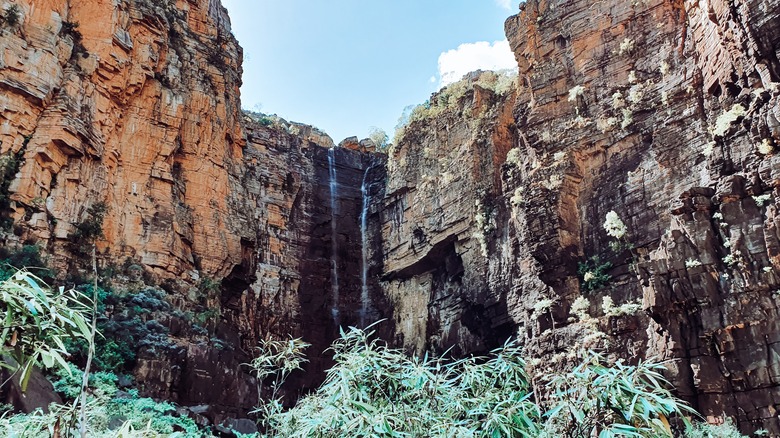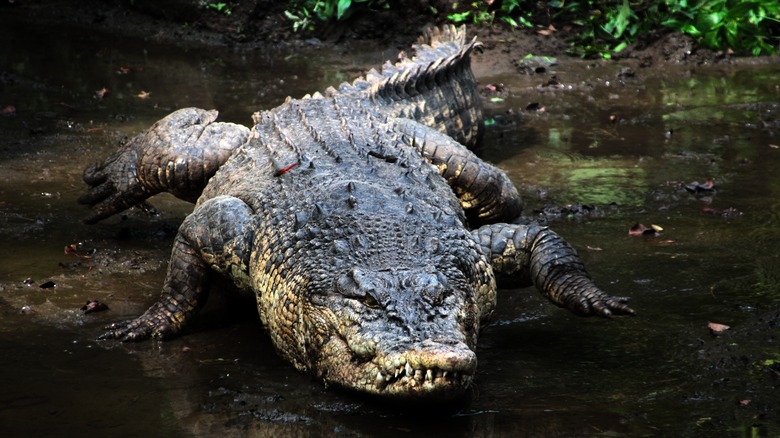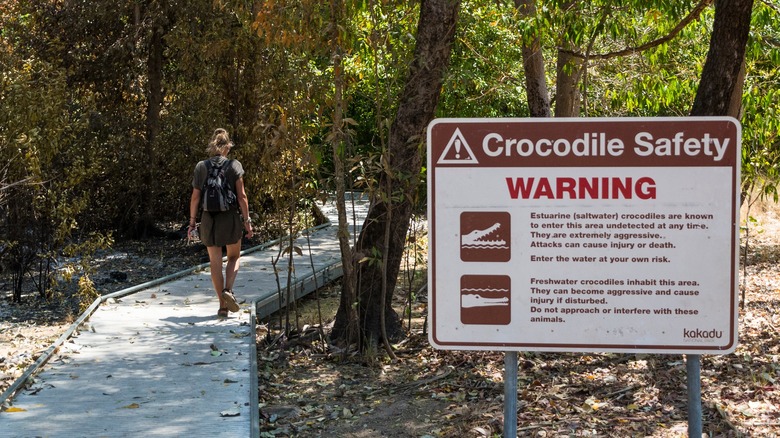One Of The World's Most Dangerous National Parks Is Full Of Australia's Deadly Wildlife
Thrill seekers, proceed with caution to this extraordinary down-under destination. A trip to Kakadu National Park is easily one of the best wildlife experiences in Australia, but it's not for the faint of heart. Creatures of all shapes and sizes call this park home, including some of the deadliest animals on earth, the chief among them being saltwater crocodiles. People have lost their lives in the crocodile-infested waters of this national park. These apex predators are only one of the dangers at Kakadu National Park. Others include venomous snakes, feral animals, and environmental risks like flash floods, dangerous roads, and heat stroke. It may not have the most shark attacks in the entire country, but it is a real threat here as well.
Dangers aside, there are many reasons to visit this breathtaking world-class wonder. Located in Australia's northern territory, Kakadu National Park is one of the largest national parks in the country, spanning over 7,700 square miles. It has the oldest living Aboriginal cultures on earth, and has been home to the First Nations people of Australia for over 65,000 years.
It's also one of Australia's destinations with UNESCO World Heritage status for its unparalleled natural scenery across multiple distinct habitats and fascinating archeological sites. The park offers guided tours, safaris, Aboriginal experiences, and many types of excursions. It also has campsites, hotels, shops, and amenities to make your visit comfortable. As long as you are well-prepared and take the safety tips seriously, your trip to Kakadu will be nothing short of magical.
The wonders (and dangers) of Australia's Kakadu National Park
Kakadu National Park is recognized for its breathtaking and diverse landscapes, including savanna woodlands, red-rock cliffs with thundering waterfalls, floodplains, wetlands, coastlines, and tidal flats. The park is also home to a huge population of native animals. Visitors can spot wallaroo, wallabies, flying foxes, and birders will be happy to know the park is home to an astounding one-third of all the bird species in Australia.
There are several dangerous and potentially deadly species to watch out for at this national park as well. Around 10,000 crocodiles live in Kakadu National Park, not including the hatchlings. Saltwater crocodiles, in particular, have attacked and killed people here and are often found lurking in waterways. It is important to be extra cautious when venturing into their territory as they are capable of surprise attacks.
Also living within the park's borders are some of Australia's most venomous snakes, including the death adder, king brown, and taipan. They are typically active at night, so hiking after sundown can be incredibly risky. Some of the world's rarest sharks have been found swimming in the park's waters. Not all sharks are dangerous to humans, but one of Kakadu's residents, the bull shark, can be if you're not careful. Visitors should also steer clear of buffaloes and wild pigs. The park's landscape itself can be hazardous, with heat stroke, flash floods, and rapid currents posing serious safety risks.
How to stay safe in Kakadu National Park
The best way to protect yourself and your travel companions from these dangerous creatures is to stay as far away from them as possible. Do not swim in areas where people fish, or at dusk and dawn, to avoid shark encounters. Stay at least 16 feet away from the water's edge, as crocodiles hunt for prey close to the shoreline. Opt for a larger watercraft than a kayak or paddle boat because crocs are known to attack people on smaller vessels. Feral buffalo and pigs can be aggressive to humans. Keep your ears open because wild animals can be heard in the distance before they are visible. Do not venture off of the marked trails and designated visitor areas unless you are with an experienced guide.
As we've mentioned, hiking at night can be dangerous due to snakes. The lack of daytime visibility also increases the risk of injury. However, hiking during the day in Kakadu National Park comes with its own set of challenges due to the high heat and extreme climate. Environmental dangers are very real here, including dehydration, heat exhaustion, and low sodium-induced hyponatremia, so adequate supplies and clothing are essential. Do not forget bug repellent, as mosquitoes may carry diseases such as Ross River virus. Be mindful of weather changes as flash floods can occur, causing dangerous rapid currents. Walk and drive carefully as the rock faces and roadways can be steep and slippery at times. If you follow these basic safety precautions, you're sure to have an incredible experience visiting Kakadu National Park.


